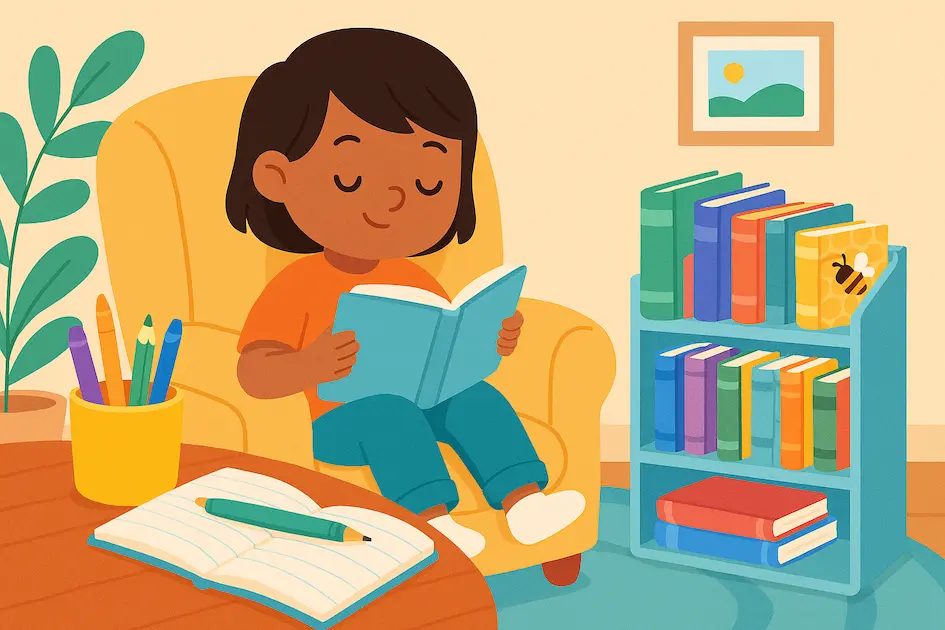How to Encourage Independent Reading at Home
Reading is one of the most powerful skills a child can develop — but turning it into a habit takes time and support. If you’re wondering how to encourage independent reading at home, you’re in good company. Many families want their kids to read more on their own, but aren’t sure where to begin. The good news? You don’t need a background in education to raise a confident, curious reader. You just need a few smart strategies and a space where books feel inviting.

What We’ll Cover
- Why independent reading matters for long-term learning
- Ways to create a reader-friendly home environment
- How to pick the right books for your child
- Tips to build a lasting reading routine
Why Independent Reading Matters
When children read on their own, they build stamina, confidence, and vocabulary. Independent reading improves comprehension, nurtures empathy, and lays the foundation for success across all subjects — not just language arts. According to the National Reading Panel, regular reading time contributes significantly to academic growth and lifelong literacy.
Step 1: Set Up a Cozy Reading Spot
You don’t need a fancy book nook to spark reading habits. A bean bag, floor cushion, or corner chair with a soft blanket will do. Add a small basket of age-appropriate books, and you’ve created a mini reading haven.
Quick Tip: Use string lights or a small reading lamp to make the space feel special without distractions.
Already have a homework station set up? You can learn how to add a reading-friendly zone nearby for after-school wind-downs.
Step 2: Let Kids Choose Their Own Books
One of the fastest ways to encourage independent reading at home is to let kids pick what they read. Whether it’s graphic novels, nonfiction, or silly stories, choice creates buy-in. Offer a mix of fiction and nonfiction books across different reading levels. Library visits, book fairs, and digital library apps are great ways to rotate in fresh material.
“The best book for your child is the one they want to read — even if it’s not what you would’ve picked.”
Step 3: Build It Into the Routine
Reading time doesn’t have to be long — it just needs to be consistent. Set aside 10–20 minutes a day for quiet reading, whether it’s before school, after homework, or as part of a bedtime routine. The goal is to make reading feel normal and expected, not a chore.
Already working on a daily rhythm? Pair this habit with your child’s morning routine or tuck it into their wind-down time at night.

Step 4: Keep Books Accessible
Kids are more likely to read if books are easy to reach and see. Use low shelves, baskets, or even a book sling so covers are visible. Rotate books by theme or season to keep things interesting — especially for early readers who love novelty.
Labeling bins by topic (“animals,” “adventure,” “funny stories”) can also help children find what they’re in the mood for.
Step 5: Celebrate Progress, Not Perfection
Don’t worry if your child rereads the same book ten times or skips pages here and there. The goal is to build a relationship with reading — not to enforce a curriculum. Celebrate milestones like finishing a chapter book or reading without being asked.
Consider using a simple reading tracker, sticker chart, or book journal. For artistic kids, let them draw a picture after finishing a story.
What If My Child Still Resists Reading?
- Try audiobooks: Listening builds language skills too — and might re-spark interest in books.
- Read aloud together: Alternate pages or characters for a shared experience.
- Model reading yourself: Kids mirror what they see. A parent reading the newspaper or novel sends a powerful message.
Final Thoughts: Keep It Light, Keep It Going
Helping your child grow into an independent reader doesn’t mean enforcing strict rules or rushing through chapter books. It means creating a home where reading feels normal, rewarding, and — most importantly — enjoyable. With a little structure and a lot of encouragement, you’ll build habits that last well beyond this school year.
Want more tools to support reading at home? Pair your book nook with a simple homework caddy or browse our favorite colored pencils for school to inspire creative book responses and journaling.
